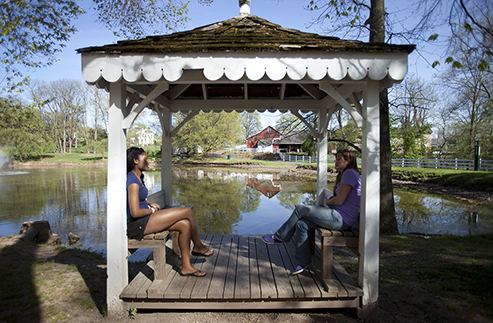Practicing Mindfulness Can Help Reduce Stress in College Students
 Courtesy: Delaware Valley University Students enjoy a break between classes at Lake Archer on Delaware Valley University's campus.
Courtesy: Delaware Valley University Students enjoy a break between classes at Lake Archer on Delaware Valley University's campus. Trying to manage time for school, clubs and ourselves in college can be stressful. In a survey published in 2013, The American Psychological Association found that 41.6 percent of college students included in the survey pool had anxiety, while 36.4 percent had depression. Time management is a skill that is heavily promoted in order to stay organized and reduce stress. But, how can we keep planning for our future without being present for what is happening right now?
Dr. Christine Molnar, who teaches counseling psychology classes at Delaware Valley University, is the founder of the Mindful Exposure Therapy for Anxiety and Psychological Wellness Center, Inc. Dr. Molnar practices mindfulness meditation and teaches clients how to develop, strengthen, and apply mindfulness practices to everyday living. She discusses these concepts in her book, "
“Mindfulness supports us in making choices that take care of our bodies, in creating both internal and external environments that we actually want to inhabit," she says. “After meditation, I felt grounded and replenished and more awake."
Dr. Molnar stated that those who seek out training in mindfulness with her tend to be "open-minded and receptive about the idea of mindfulness.”
She said she has personally seen many young adults benefit from practicing mindfulness.
Practicing mindfulness can lead to many health benefits according to Dr. Molnar. Dr. Molnar said that mindfulness can enhance functions such as memory, focus, and attention. She said practicing mindfulness can also help people to switch attention away from thoughts that increase stress toward thoughts that enhance well-being.
Mindfulness is training in metacognition or the capacity to be aware of and understand your thought processes. Emotions can be deconstructed into a mental activity like thinking and remembering, how thoughts impact the body; and how such body activation can drive behavior. She suggests breaking strong emotions down into their components so that you can respond as intended rather than reactively in ways that are “sometimes not useful.”
Mindfulness can also better one’s physical health, such as lowering blood pressure, strengthening the immune system, and reducing chronic pain.
“People learn mindfulness to enhance athletic and other kinds of performance where high levels of stress can interfere with optimal functioning,” said Dr. Molnar.
She said mindfulness can also help people relate well with both themselves and others; manage stress; live life in alignment with what their values; and experience greater peace.
“In general, mindfulness reduces the toll that chronically elevated stress physiology can take on the body and the mind,” said Dr. Molnar.
So, how can you practice mindfulness? Dr. Molnar recommended a variety of practices. Below are some exercises you can try to get started with mindfulness.
The Three-Minute Breathing Space
To try “The Three-Minute Breathing Space,” practice noticing experiences in the mind, body, and behavior with a friendly and curious presence. Essentially practice “non-doing” instead of the habitual and frantic doing we humans tend to engage in day to day without awareness.”
“Mindfulness is an awareness that is friendly to self and others: It is supported by returning again and again to an anchor such as sounds, touch sensations including the breath coming and going,” said Dr. Molnar.
She suggests noticing broadly what is getting attention and gently noting it sometimes but not thinking about it and definitely not doing anything about it for the period of formal practice. By the end of the day, one could meditate for about 30 minutes by taking a minute here and there throughout the day to do this informally.
Drop In
Another informal mindfulness practice that Dr. Molnar recommends is to “drop in” with any activity that is taking place. Some examples include: focusing on the taste and smell of the food you’re eating; noticing sensations like touch and temperature; focusing on how it feels to move your arms and legs while you’re exercising; or looking around at visual sensations like light, color, shape, and texture.
Friendliness or Compassion Meditation
There are also some more structured practices that require protecting time to practice aiming and sustaining attention with intention. Dr. Molnar suggested the concept of “Friendliness or Compassion Meditation,” which focuses on improving self-compassion. This is done through “creating conditions of kindness through mental and behavioral choices.”
Mindfulness Audios
Initially, it can help to use guided audio mindfulness meditation exercises. These guided audio sessions take the listener through the process of practicing a variety of mindfulness meditation exercises and, can be a great resource for beginners.
Body Scan Meditation
During a “Body Scan Meditation,” you focus on different parts of the body and how they are feeling at a level of sensations rather than perception.
Getting Started with Mindfulness
After learning about the various types of mindfulness exercises DelVal student, Marybeth Fennelly stated that she was unsure about the practice.
“I would definitely struggle to stay focused,” said Fennelly.
However, after a breathing space practice, which required one to focus on their breathing, sounds, and touch, she felt more confident.
“I’m really grateful that I did it,” said Fennelly. “It brought me to a good part of my mind and it made me want to keep practicing.”
While mindfulness takes some time to practice it offers strong benefits. Focusing on the present can help with understanding where you want to go in the future. Give yourself permission to take a moment or two to collect yourself and take a breath. As a matter of fact, make sure you do. It will help you out more than you’re aware of.